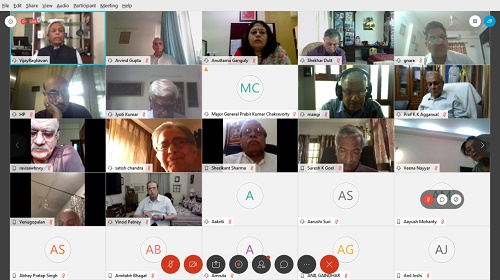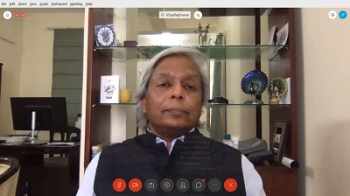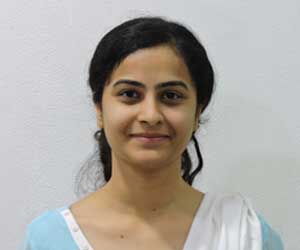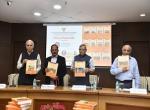On 10 July, 2020, the Vivekananda International Foundation conducted an online Vimarsha lecture on India's Efforts towards Developing a Vaccine to Fight the Coronavirus. The speaker for the session was Prof. K Vijay Raghvan, the Principal Scientific Adviser to the GOI. Dr Arvind Gupta initiated the session by introducing the esteemed speaker. Apart from the important positions that he has held in government departments, he was instrumental in setting up the National Centre for Biological Sciences. Dr Gupta also highlighted the importance of the office of the Principal Scientific Advisor in dealing with all matters scientific and technological for the welfare of the country.
Prof. Raghvan in turn built on how Science and Technology (S&T) is important for a country as ours and how are we dealing with the COVID-19 crisis through S&T. Prof highlighted India’s unusual efforts in developing its S&T amongst post-colonial countries. He alluded to the investments in establishing centres like CSIR, ICAR, and in Indian Space Programme, Atomic Energy Programme, among other higher education institutions. However, there were major gaps in our system which hardened with time. These were the gaps in two major areas namely, the industry and civil society. The investment in higher education and R&D was not matched by investments in primary education. This resulted in a non-uniform development. While industry developed at the cost of innovation and expansion of R&D. Although Indian industries had the capital, they lacked the risk-capital which was leveraged by industries all over the world. This poses a unique challenge for India, more so in a crisis like the pandemic.
Prof mentioned how countries like China have heavily invested in S&T since WWII. China, he marks, has invested both internally and by exposing Chinese students to best American universities which has allowed China to stand on the foundation of an extremely credible innovative system. A close connection with its human resources has therefore taken China far in this race. However, Indians play a much larger role in the S&T industries all over the world today. This, he suggests is due to the ways in which S&T has changed and paved path for core capabilities which is possessed by Indians.

New Science and Technology today is immensely cyber physical. This allows all of the designing, manufacturing and technologies to be increasingly connected with the cyber world and done in one location. This provides an opportunity for Indian designing capabilities to be leveraged even it doesn’t have the high end capabilities. Simultaneously, the growth of big data is both a promise to be grasped and a danger to be avoided. By increasing its focus and investments in these two areas, India can be among the few countries who will play a major role in decision making in the use of Artificial Intelligence for social good, agriculture, health etc. The third aspect mentioned by Prof, is the combination of energy- conventional, nuclear and renewable and its availability. With this kind of power available to everyone, including the rural population, our economy can be transformed in rather interesting ways. This however requires concerted efforts and huge investments before the benefits can be realised. In parallel we need to go for the long haul and look at bringing in “traditional manufacturing” back in the country, including semiconductor, equipment for textiles and other heavy industries.
Having discussed the roadmap for Indian S&T system, Prof Raghavan then alludes to the promising attitudes which have come to the fore from our responses to COVID-19. The manner in which our industries came together for PPE, Masks, Ventilators and other type of devices to combat the pandemic has been extraordinary. He observes the combined efforts of our aeronautics industry, mathematicians, condensed matter physicists, entrepreneurs and other specialists who have pooled in for this cause. The way our industries and academia have broken the silos this time is admirable and needs to stay on. Concurrently, we must look into the reasons why this did not happen earlier. The PSA highlighted some of these reasons as lack of enthusiasm and various restrictions which held back a flexible interaction between the academia, industry and government.
Lastly, the PSA discussed the COVID-19 pandemics in the context of pandemics in general and vaccine development process. The increasing intensity of human interaction with various animals and birds in the present times is alarming and what he calls is a bad lottery ticket which has been bought in large numbers. This was manifested in the current pandemic as well where the virus got transmitted from a bat to a human. Typically, a vaccine must be tested for three things, namely, safety, immunogenicity and efficacy. This can easily take upto 15-20 years with huge costs involved to test it on normal people, without a terminal illness. The trials go through phases to check for the above-mentioned parameters. For Sars-COV-2, this process has been compressed while maintaining rigorous evaluation at each phase. This is a major call on our regulatory and testing systems. Moreover, to expedite the process further, instead of manufacturing at the end of trials, people are manufacturing the vaccines in parallel to the testing. This is a huge investment cost which is being raised for stockpiling the vaccines, in case it succeeds.
Indian vaccine manufacturers are known to be the best in the world. Most importantly, this time around Indians have gone into the discovery process of vaccines, instead of being mere manufacturers. This is another unique feat which the PSA points, India have achieved. He informs that there are over 20 vaccines being developed in India, with the two of them- one by Bharat Biotech and other one by Zydus Cadila having gone into the Phase-I trial. He assured that Indian Regulatory bodies looking into the vaccines will speed up the process without compromising on the safety. Indian companies have also been partnering with global companies for the vaccine development, while they are ramping up their manufacturing capabilities. Our Department of Biotechnology has put in place more clinical trial platforms to test the effectiveness of the vaccine, which will be very valuable. The Government of India is putting in place measures for the distribution of vaccines to all age-groups and states alike, in a salt and pepper manner. Notwithstanding that we have a lot more to learn about the disease itself, we have developed a solid understanding on the disease biology and the PSA is confident when he says a vaccine or a drug is very likely to happen.
In further discussions and Q&A, he discussed how the definition of MSMEs has changed over time and more so in this emergency. Thereby, the gaps between MHRD and MSMEs have been bridged and they must stay so for us to bring in new tech into the country. He also brought out that deep partnership between big private sector players and MSMEs is an imperative for the Indian R&D to flourish in the future. The government has to overcome the challenges which hinder this partnership. Furthermore, volume of quality in our research can be ensured by the proposed New National Research Foundation which will invest hugely in R&D in a state university system and take up big science missions of various kinds of national interest like a DARPA model of DRDO. Simultaneously, a Science, Technology and Innovation policy is underway, which aims to connect a wish list of the nation with the transmission and wheels. This brings in a dose of realism which includes an investment in the future, even if the results are a little while longer. The longer the journey, it is all the more reason to start this journey now. The pandemic has indeed spurred this movement.
Responding to a question on production of non-edible bio-fuels the PSA noted that we do possess the technology to do so. However, the supply chain management and a competitive pricing for these biofuels is where we are lacking as of now.
On the possibility of genetic engineering of the Sars-COV-2 virus, Prof responded by saying that while one can theoretically construct scenarios of genetically engineering the virus, it is very unlikely by multiple arguments, that it happened in this case. The sequence of the virus, compared to its predecessors, is a proof that it was not created in the laboratory. Also, he hopes that one vaccine for now will do the job of curbing the virus, whose mutants are not yet known to us.
When asked about a realistic time-frame by which the vaccines will be available in India, Prof stressed on the availability factor, which he thinks will be spread out over a year or two even after the vaccines start rolling out in different parts of the world. He also pointed that there are coalitions who are making vaccines for diseases (NEPA, Congo hemorrhagic fever, chikungunya etc) that are at very early stages in the possibility that they might become pandemics. These are the kind of insurance investments which have to be borne by the pharma companies and public alike in tackling any such crisis in future.
On the status of R&D in Indian Medicine Systems in COVID-19 and otherwise, Prof emphasises on the need for a systematic documentation and approach, which is required for Ayurveda and modern medicine to work together in present times. This needs to be done on scale. The Ministry of AYUSH must work together with our labs, so that a middle ground is met between testing and doing. There is enormous opportunity in terms of validation and a global market for studying Ayurveda better. For this pandemic a major antiviral drug is with tests by CSIR in collaboration with IGIB, DBT and a pharma company.
Startup ecosystem, which has also taken a hit during the pandemic, requires a market ecosystem and a strong academic as well as industrial links. Investment and mentorship are also big challenges which we need to resolve in the Indian scenario. For any kind of entrepreneurship in deep tech, government should be enabling instead of micro-managing such projects. Prof referred to the Andhra Pradesh metric zone as a case in point.






Post new comment